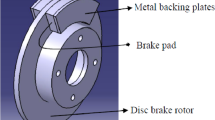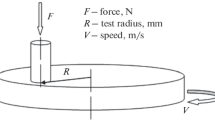Abstract
With weight reduction and component reliability being the top priority while designing automobile components, the selection and use of materials of a high strength-to-weight ratio is of vital importance. Less weight ensures low fuel consumption and hence low emissions thus having a great impact on the environment on a large scale. Brake rotors are one of the most important components in an automobile, which aid in stopping the vehicle by converting the kinetic energy of the moving vehicle into heat energy by means of friction. This study focuses on the use of abrasive particle (SiC)-reinforced aluminum metal matrix composite material for brake rotors which is expected to generate less heat during braking (due to friction) and also reduces the unsprung mass of the vehicle resulting in better handling. This paper discusses the design, structural, and thermal analysis; the manufacturing method; and the testing of silicon carbide-reinforced aluminum (Al 6061) matrix composite material for motorcycle brake rotor.
Similar content being viewed by others
References
Maleque MA, Dyuti S, Rahman MM (2010) Material selection method in design of automotive brake disc, Proceedings of the World Congress on Engineering. Vol 3,WCE 2010, London
Belhocine A, Bouchetara M (2012) Thermal analysis of a solid brake disc. Appl Therm Eng 32:59–67
Heisler H (2002) Advanced vehicle technology. SAE International, Warrendale
Blau PJ, Jolly BC, Qu J, Peter WH, Blue CA (2007) Tribological investigation of titanium-based materials for brakes. Wear 263:1202–1211
US Patent Number 4,890,700 dated Jan 2, 1990
US Patent Number 5,901,818 dated May11, 1999
Nakagawa Y, Takahashi S, Masaki M, Imao R (2014) Study of effects of residual stress on natural frequency of motorcycle brake discs. SAE Int J Passenger Car Mech Syst 7(4):1435–1445
North American Light Vehicle Aluminum Content Study (2015) www.ducker.com
Dharmalingam S (2011) Investigations on Tribological behavior of Al alloy metal matrix and hybrid composite. Dissertation,Anna University,Chennai
Miracle DB (2005) Metal matrix composites—from science to technological significance. Compos Sci Technol 65:2526–2540
Meena KL, Manna A, Banwait SS, Jaswanti (2013) An analysis of mechanical properties of the developed Al/SiC-MMC’s. Am J Mech Eng 1(1):14–19
Manoj S, Deepak Dwivedi D, Singh L, Chawla V (2009) Development of Aluminium based silicon carbide particulate metal matrix composite. J Miner Mater Charact Eng 8(6):455–467
Hashim J, Looney L, Hashmi MSJ (1999) Metal matrix composites: production by the stir casting method. J Mater Process Technol 92:1–7
Beffort O, Long S, Cayron C, Kuebler J, Buffat P-A (2007) Alloying effects on microstructure and mechanical properties of high volume fraction SiC-particle reinforced Al-MMCs made by squeeze casting infiltration. Compos Sci Technol 67:737–745
Faiz A, Jason Lo SH, Aslam M, Haziq A (2013) Tribology behaviour of alumina particles reinforced aluminium matrix composites and brake disc materials. Procedia Eng 68:674–680
Kumar A, ShyamLal SK (2013) Fabrication and characterization of A359/Al2O3 metal matrixcomposite using electromagnetic stir casting method. J Mater Res Technol 2(3):250–254
Ravindran P, Manisekar K, Narayanasamy R, Narayanasamy P (2013) Tribological behaviour of powder metallurgy-processed aluminium hybrid composites with the addition of graphite solid lubricant. Ceram Int 39:1169–1182
Siegert K, Unseld P, Baur J, Kauffmann F, Arzt E, Niessen K v (2006) Thixoforging of continuous fiber-reinforced AlSi/AlMg-alloys. Int J Mach Tools Manuf 46:1227–1232
Wenzelburger M, Silber M, Gadow R (2010) Manufacturing of light metal matrix composites by combined thermal spray and semi solid forming processes-summary of the current state of technology. Key Eng Mater 425:217–244
Li W, Liang H, Chen J, Zhu SQ, Chen YL (2014) Effect of SiC particles on fatigue crack growth behavior of SiC particulate-reinforced Al-Si alloy composites produced by spray forming. Procedia Mater Sci 3:1694–1699
Rehman A, Das S, Dixit G (2012) Analysis of stir die cast Al_SiC composite drums based on coefficient of friction. Tribol Int 51:36–41
Idusuyi N, Babajide I, Ajayi OK, Olugasa TT (2014) A Computational study on the use of an aluminium metal matrix composite and aramid as alternative brake disc and brake pad material. J Eng 10:1–5
Zhang S, Wang F (2007) Comparison of friction and wear performances of brake materials containing different amounts of ZrSiO4 dry sliding against SiCpreinforced Al matrix composites. Mater Sci Eng A443:242–247
Lakkam S, Suwantaroj K, Puangcharoenchai P, Mongkonlerdmanee S, Koetniyom S (2013) Study of heat transfer on front– and back-vented brake discs. Songklanakarin J Sci Technol 35(6):671–681
Rajasekaran S, Udayashankar NK, Nayak J (2012) T4 and T6 treatment of 6061 Al-15 Vol.%SiCP Composite. ISRN Mater Sci 10:1–5
Ramesh KC, Sager R (1999) Fabrication of metal matrix composites for automotive parts. Int J Adv Manuf Technol 15:114–118
Prohit R, Sager R (2001) Fabrication of cam using metal matrix composites. Int J Adv Manuf Technol 17:644–648
Devi N, Selvaraj N, Mahesh V (2012) Micro structural aspects of aluminium silicon carbide metal matrix composite. Int J Appl Sci Eng Res 1(2):250–254
Aravindan S, Rao PV, Ponappa K (2015) Evaluation of physical and mechanical properties of AZ91D/SiC composites by two step stir casting process. J Magnes Alloys 3:52–62
Uyyuru RK, Surappa MK, Brusethaug S (2006) Effect of reinforcement volume fraction and size distribution on thetribological behavior of Al-composite/brake pad tribo-couple. Wear 260:1248–1255
Gultekin D, Uysal M, Aslan S, Alaf M, Guler M.O, Akbulut H (2010) The effects of applied load on the coefficient of friction in Cu-MMC brake pad/Al-SiCp MMC brake disc system. Wear 270:73–82
Daoud A, Abou El-khair MT (2010) Wear and friction behavior of sand cast brake rotor made of A359-20 vol% SiC particle composites sliding against automobile friction material. Tribol Int 43:544–553
Antaraits DB (2013) Engineered surface features of brake discs to improve performance in fade condition. SAE Int J Passenger Car Mech Syst 6(3):1418–1429
Oda N, Sugimoto Y, Higuchi T, Minestia K (1997) Development of disc brake rotor utilizing Al Metal matrix composite. SAE Technical paper
Surappa MK (2003) Aluminium matrix composites: challenges and opportunities. Sadhana 28:319–334
Skolianos S (1996) Mechanical behavior of cast SiCp –reinforced Al-4.5%Cu-1.5% Mg alloy. Mater Sci Eng 210:72–82
SedatOzden RE, Nair F (2007) Investigation of impact behaviour of aluminium based SiC particle reinforced metal–matrix composites. Compos Part A 38:484–494
ManojSingla DD, Singh L, Chawla V (2009) Development of aluminium based silicon carbide particulate metal matrix composite. J Miner Mater Charact Eng 8(6):455–467
Lan J, Yan-li J, Yu L, Nan S, You-dong D (2012) Thermal analysis for brake disks of SiC/6061 Al alloy co-continuous composite for CRH3 during emergency braking considering airflow cooling. Trans Nonferrous Met Soc China 22:2783–2791
Talati S, Jalalifar S (2008) Investigation of heat transfer phenomena in a ventilated disc brake rotor with straight radial round vanes. J Appl Sci 8(20):3583–3592
Surappa MK (1997) Microstructural evolution during solidification of DRMMCs: state of art. J Mater Process Technol 63:325–333
Hashim J, Looney L, Hashmi MSJ (1998) Particle distribution in cast MMCs—part II, Proceeding of the 4th International Conference, on Advances on Materials and Processing Technologies, Kuala Lumpur, 349–358
Stefanesfu DM, Ajuha S, Dhindaw BK, Phalnikar R (1993) Modelling of particle distribution in Equiaxed-grains metal matrix composites, proc. of the 2nd Int. Conf. On the processing of semi-solid alloy and composites, Cambridge, MA, USA, TMS Minerals,Metals and Materials Society, 406–416
ASM Handbook (1991) Volume 4—heat-treating, ASM International , 1861-1960
Author information
Authors and Affiliations
Corresponding author
Rights and permissions
About this article
Cite this article
P., S., Natarajan, H.K. & J., P. Study of silicon carbide-reinforced aluminum matrix composite brake rotor for motorcycle application. Int J Adv Manuf Technol 94, 1461–1475 (2018). https://doi.org/10.1007/s00170-017-0969-7
Received:
Accepted:
Published:
Issue Date:
DOI: https://doi.org/10.1007/s00170-017-0969-7




